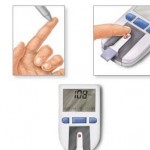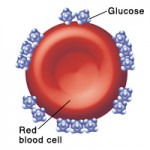The A1c test is used to monitor the glucose control of diabetics over time. The goal of those with diabetes is to keep their blood glucose levels as close to normal as possible. This helps to minimize the complications caused by chronically elevated glucose levels, such as progressive damage to body organs like the kidneys, eyes, cardiovascular system, and nerves. The A1c test  result give a picture of the average amount of glucose in the blood over the last few months. They can help you and your doctor know if the measures you are taking to control your diabetes are successful or need to be adjusted.
A1c is frequently used to help newly diagnosed diabetics determine how elevated their uncontrolled blood glucose levels have been. It may be ordered several times while control is being achieved, and then several times a year to verify that good control is being maintained.
The A1c test may be used to screen for and diagnose diabetes. However, A1c should not be used for diagnosis in pregnant women, people who have had recent severe bleeding or blood transfusions, those with chronic kidney or liver disease, and people with blood disorders such as iron-deficiency anemia, vitamin B12 anemia, and hemoglobin variants. Also, only A1c tests that have been referenced to an accepted laboratory method (standardized) should be used for diagnostic or screening purposes. In these cases, a fasting plasma glucose or oral glucose tolerance test may be used for screening or diagnosis. Currently, point-of-care tests, such as those that may be used at a doctor’s office or a patient’s bedside, are too variable for use in diagnosis but can be used to monitor treatment (lifestyle and drug therapies).
When is it ordered?
Depending on the type of diabetes that you have, how well your diabetes is controlled, and your doctor, your A1c may be measured 2 to 4 times each year. The American Diabetes Association recommends testing your A1c at least twice a year. When someone is first diagnosed with diabetes or if control is not good, A1c may be ordered more frequently.
For diagnostic and screening purposes, A1c may be ordered as part of a health checkup or when someone is suspected of having diabetes because they have signs or symptoms of increased blood glucose levels (hyperglycemia) such as:
- Increased thirst
- Increased urination
- Fatigue
- Blurred vision
- Slow-healing infections
What does the test result mean?
For monitoring glucose control, A1c is currently reported as a percentage, and it is recommended that diabetics aim to keep their A1c below 7%. The report for your A1c test also may include an estimated Average Glucose (eAG), which is a calculated result based on your A1c levels. The purpose of reporting eAG is to help you relate your A1c results to your everyday glucose monitoring levels. The formula for eAG converts percentage A1c to units of mg/dL or mmol/L so that you can compare it to your glucose levels from home monitoring systems or laboratory tests.
It should be noted that the eAG is still an evaluation of your glucose over the last couple of months. It will not match up exactly to any one daily glucose test result. The American Diabetes Association has adopted this calculation and provides a calculator and information on the eAG on their web site.
The closer a diabetic can keep their A1c to 6% without experiencing excessive hypoglycemia, the better their diabetes is in control. As the A1c and eAG increase, so does the risk of complications.
In screening and diagnosis, some results that may be seen include:
- A nondiabetic person will have an A1c result between 4% and 6%.
- Diabetes: A1c level is 6.5% (47 mmol/mol) or higher.
- Pre-diabetes (increased risk of developing diabetes in the future): A1c is 5.7% – 6.4% (39 – 46 mmol/mol)
Is there a home test for A1c?
 Yes. If you have already been diagnosed with diabetes, a home test may be used to help monitor your glucose control over time. However, a home test is not recommended for screening or diagnosing the disease. There are FDA-approved tests that can be used at home. If you are interested in learning more, ask your doctor.
Yes. If you have already been diagnosed with diabetes, a home test may be used to help monitor your glucose control over time. However, a home test is not recommended for screening or diagnosing the disease. There are FDA-approved tests that can be used at home. If you are interested in learning more, ask your doctor.Is there anything else I should know?
The A1c test will not reflect temporary, acute blood glucose increases or decreases. The glucose swings of someone who has “brittle” diabetes will not be reflected in the A1c.
If you have a hemoglobin variant, such as sickle cell hemoglobin (hemoglobin S), you will have a decreased amount of hemoglobin A. This may limit the usefulness of the A1c test in diagnosing and/or monitoring your diabetes. If you have anemia, hemolysis, or heavy bleeding, your test results may be falsely low. If you are iron deficient, you may have an increased A1c measurement. If you have had a recent transfusion, then your A1c will be falsely increased (blood preservative solutions contain high glucose levels) and not accurately reflect your glucose control for 2 to 3 months.


